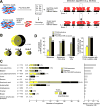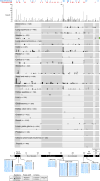Comprehensive analysis of cancer-associated somatic mutations in class I HLA genes
- PMID: 26372948
- PMCID: PMC4747795
- DOI: 10.1038/nbt.3344
Comprehensive analysis of cancer-associated somatic mutations in class I HLA genes
Abstract
Detection of somatic mutations in human leukocyte antigen (HLA) genes using whole-exome sequencing (WES) is hampered by the high polymorphism of the HLA loci, which prevents alignment of sequencing reads to the human reference genome. We describe a computational pipeline that enables accurate inference of germline alleles of class I HLA-A, B and C genes and subsequent detection of mutations in these genes using the inferred alleles as a reference. Analysis of WES data from 7,930 pairs of tumor and healthy tissue from the same patient revealed 298 nonsilent HLA mutations in tumors from 266 patients. These 298 mutations are enriched for likely functional mutations, including putative loss-of-function events. Recurrence of mutations suggested that these 'hotspot' sites were positively selected. Cancers with recurrent somatic HLA mutations were associated with upregulation of signatures of cytolytic activity characteristic of tumor infiltration by effector lymphocytes, supporting immune evasion by altered HLA function as a contributory mechanism in cancer.
Conflict of interest statement
Work of this paper is included in patent applications.
Figures




References
Publication types
MeSH terms
Substances
Grants and funding
LinkOut - more resources
Full Text Sources
Other Literature Sources
Research Materials

